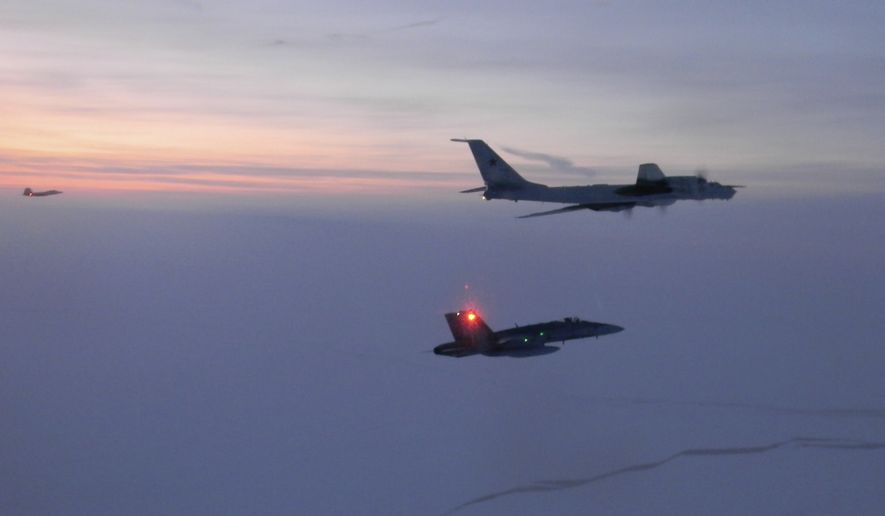The Chinese military jet pilot who nearly collided with a U.S. reconnaissance aircraft last month was solely responsible for the dangerous encounter, a spokesman for the U.S. Indo-Pacific Command said Tuesday
“The J-11 fighter pilot performed an unsafe maneuver during the intercept of our U.S. Air Force RC-135 aircraft, which was lawfully conducting routine operations over the South China Sea in international airspace,” said Navy Capt. Kyle Raines. “It was the actions of the [People’s Liberation Army Navy] pilot that forced the RC-135 to take evasive maneuvers to avoid a collision.”
On Sunday, a Chinese military spokesman denied an earlier Indo-Pacific Command statement on the Dec. 21 incident over the northern waters of the South China Sea, where U.S. military aircraft and ships routinely conduct freedom of navigation operations to contest Chinese claims to owning most of the sea.
PLA Air Force Sr. Col. Tian Junli, spokesman for the military’s Southern Theater Command, dismissed the U.S. account of the confrontation “slander and speculation.”
“During the process, in disregard of repeated warnings from the Chinese pilot, the U.S. aircraft abruptly changed its flight attitude and forced the Chinese aircraft to the left,” the PLA statement said.
The Chinese accused the U.S. aircraft of violating a 2015 U.S.-China memorandum of understanding that attempted to set rules for aerial intercepts. However, military specialists familiar with the memorandum said the Chinese J-11 jets have repeatedly violated the agreement that calls for all aerial intercepts to be no closer than 500 feet.
Video of the Dec. 21 incident released by both the Pentagon and the Chinese military does not support the Chinese claims of a violation of the memorandum. The video shows the J-11 flying within an estimated 20 feet of the RC-135 reconnaissance aircraft. The J-11 then flies ahead of the RC-135, a maneuver that military experts say left the Chinese pilot out of visual sight of the U.S. aircraft.
The J-11 then began drifting closer to the RC-135, a heavy aircraft that is unable to make rapid maneuvers, forcing the American pilot to drop down in altitude to avoid a collision.
Indo-Pacific Command officials said the J-11 made an “unsafe maneuver” in flying in front of the RC-135 within 20 feet of the nose of the 1950s-era aircraft.
“The U.S. Indo-Pacific Joint Force is dedicated to a free and open Indo-Pacific region and will continue to fly, sail and operate at sea and in international airspace with due regard for the safety of all vessels and aircraft under international law,” the statement said. “We expect all countries in the Indo-Pacific region to use international airspace safely and in accordance with international law.”
The incident is said to have prompted a formal protest from the U.S. government.
In 2001, a Chinese J-8 pilot collided in mid-air with a Navy EP-3 signals intelligence aircraft over the South China Sea.
The collision led to the death of the Chinese pilot in a crash into the sea and nearly downed the EP-3. The EP-3 made an emergency landing at a Chinese base where the crew was imprisoned for 10 days before the George W. Bush administration negotiated their release.
China forced the United States to dismantle the aircraft before it could be removed from Hainan, and the incident led to a temporary cutoff in U.S.-China military exchanges.
U.S.-China tensions remain high over flashpoints in the region, including Taiwan where senior U.S. officials have said China is speeding up its plans for seeking to take over the island democracy it considers part of China’s sovereign territory.
The South China Sea also has been a flashpoint where U.S. Navy warships regularly sail in pushing back against Chinese territorial claims. In recent months, U.S. forces have been joined by several
U.S.-allied navies in South China Sea operations.
China said the RC-135 crew made a close-in reconnaissance pass near the southern Chinese coastline and near the Paracel Islands, disputed South China Sea islands that now host major Chinese military facilities.
“We sternly demand the U.S. side to restrain the operations of its front-line air and naval troops, strictly abide by relevant international laws and agreements, and prevent any accidental event at sea and in the air,” Col. Tian said.
The Indo-Pacific Command statement said the RC-135 was flying in international airspace — not over Chinese territory — and thus was legally permitted to conduct flights.
• Bill Gertz can be reached at bgertz@washingtontimes.com.




Please read our comment policy before commenting.